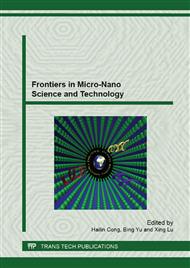[1]
S.G. Liu, X.L. Zhang, J.P. Li, et al, Preparation and application of stabilized mesoporous MgO–ZrO2 solid base, Catalysis Communications. 9 (2008) 1527-1532.
DOI: 10.1016/j.catcom.2007.12.007
Google Scholar
[2]
M. Mamak, N. Coombs, G. Ozin, Self-Assembling solid oxide fuel cell materials: mesoporous yttria-zirconia and metal-yttria-zirconia solid solutions, J. Amer. Chem. Soc. 122 (2000) 8932-8939.
DOI: 10.1021/ja0013677
Google Scholar
[3]
H. Verweij, Nanocrystalline and Nanoporous Ceramics, Adv. Mater. 10 (1998) 1483-1486.
DOI: 10.1002/(sici)1521-4095(199812)10:17<1483::aid-adma1483>3.0.co;2-j
Google Scholar
[4]
W.L. Xie, H. Peng, L.G. Chen, Transesterification of soybean oil catalyzed by potassium lead on alumina as a solid-base catalyst, Applied Catalysis A: General. 300 (2006) 67-74.
DOI: 10.1016/j.apcata.2005.10.048
Google Scholar
[5]
S. Furuta, H. Matsuhashi, K. Arata, Biodiesel fuel production with solid amorphous-zirconia catalysis in fixed bed reactor, Biomass and Bioenergy. 30 (2006) 870-873.
DOI: 10.1016/j.biombioe.2005.10.010
Google Scholar
[6]
G. Pacheco, J.J. Fripiat, Physical chemistry of the thermal transformation of mesoporous and microporous zirconia, J. Phys. Chem. B. 104 (2000) 11906-11911.
DOI: 10.1021/jp001455d
Google Scholar
[7]
Y.J. Wang, Y.F. Ying, P. Fang, et al, PrOy-ZrO2 solid solution: characterization and catalytic oxidation of CO, Chinese Journal of Inorganic Chemistry. 7 (2006) 1251-1256.
Google Scholar
[8]
S.G. Chen, Y.S. Yin, C.H. Zhou, Application and study on the mechanism of the phase-stabilized zirconia, Bulletin of the Chinese Ceramic SocIety. 3 (2004) 73-76.
Google Scholar
[9]
Y.X. Zhu, W. Zhuang, D.E. Jiang, et al, The basicity and dispersion state of alkaline earth metal compounds on the surface of ZrO2, Chinese Journal of Catalysis. 21 (2000) 34-35.
Google Scholar
[10]
Y. Ono, T. Baba, Selective reactions over solid base catalysts, Catalysis Today. 38 (1997) 321-337.
DOI: 10.1016/s0920-5861(97)81502-5
Google Scholar
[11]
K. Tanabe, W.F. Hoelderich, Industrial application of solid acid-base catalysts, Applied Catalysis A: General. 181 (1999) 399-434.
DOI: 10.1016/s0926-860x(98)00397-4
Google Scholar
[12]
G.D. Feng, W.M. Li, J.B. Pan, et al, Synthesis of Biodiesel with Solid base CaO/MgO as catalyst, Chinese Journal Of Applied Chemistry. 10 (2007) 1149-1152.
Google Scholar
[13]
H. Hattori, Solid base catalysts: generation of basic sites and application to organic synthesis, Appl Catal A: General. 222 (2001) 247-259.
DOI: 10.1016/s0926-860x(01)00839-0
Google Scholar
[14]
A. Stein, B.J. Melde, R.C. Schroden, Hybrid inorganic–organic mesoporous silicates-nanoscopic reactors coming of age, Adv. Mater. 12 (2000) 1403-1419.
DOI: 10.1002/1521-4095(200010)12:19<1403::aid-adma1403>3.0.co;2-x
Google Scholar
[15]
M.E. Davis, Ordered porous materials for emerging applications, Nature. 417 (2002) 813-821.
DOI: 10.1038/nature00785
Google Scholar
[16]
M. Rezaei, S.M. Alavi, S. Sahebdelfar, et al, Effect of process parameters on the synthesis of mesoporous nanocrystalline zirconia with triblock copolymer as template, Journal of Porous Materials. 15 (2008) 171-179.
DOI: 10.1007/s10934-007-9120-8
Google Scholar
[17]
M. Rezaei, S.M. Alavi, S. Sahebdelfar, et al, A highly stable catalyst in methane reforming with carbon dioxide, Scripta Materialia. 61 (2009) 173–176.
DOI: 10.1016/j.scriptamat.2009.03.033
Google Scholar
[18]
S.K. Das, M.K. Bhunia, A.K. Sinha, et al, Self-assembled mesoporous zirconia and sulfated zirconia nanoparticles synthesized by triblock copolymer as template, J. Phys. Chem. C. 113 (2009) 8918-8923.
DOI: 10.1021/jp9014096
Google Scholar
[19]
F.Q. Zhu, Z.H. Wang, J.F. Xia, et al, Synthesis and characterization of mesoporous zirconia with high thermal stability, Journal of Instrumental Analysis. 12 (2011) 1440-1443.
Google Scholar
[20]
A.P. Mirgorodsky, M.B. Smirnov, P.E. Quintard, Phonon spectra evolution and soft-mode instabilities of zirconia during the c–t–m transformation, Journal of Physics and Chemistry of Solids. 60 (1999) 985-992.
DOI: 10.1016/s0022-3697(99)00005-0
Google Scholar
[21]
Z.H. Lin, G. Lin, L. Wu, et al, Phase structure and transformation of zirconia, Chinese Journal of Rare Metals. 27 (2003) 49-52.
Google Scholar


